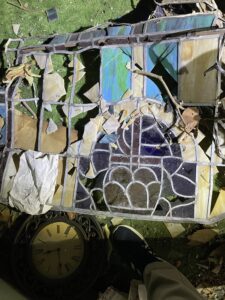On the night of March 24, The Reverend Greg Proctor of Chapel of the Cross, Rolling Fork, got an unexpected call from the church’s alarm company alerting him that a fire alarm had gone off in the building. Perplexed, he gave his Senior Warden, Charles Weissinger, a call.
“I called him and he said, ‘I can’t talk right now, there’s a tornado going over my roof,’” says Proctor. “And I thought, my Lord in heaven, what is going on?”

What was going on was an extremely powerful EF-4 storm, the most destructive of an outbreak of tornadoes that did extensive damage in communities across central and northern Mississippi, including the towns of Midnight, Silver City, New Wren, and Amory.
Weissinger and his wife, Anne, had their 5-year-old grandson, Fisher, spending the night with them when they heard a freight train approaching their house. Knowing there were no tracks nearby, Weissinger grabbed the young boy and ran downstairs.
“I laid down on Fisher at the landing,” he recalls. “Anne was at the bottom of the stairs. Glass and debris flew just over my head. Anne dove for the couch in the living room. The stairs to the attic blew down and insulation rained down on us. Fisher was about to graduate from kindergarten. I asked God to take me and spare him if possible. Then it was gone. Three minutes from beginning to end.”
In those three minutes, the storm had taken with it much of the town of Rolling Fork—78% of structures in the town were damaged and, even more tragically, 17 lives were lost. For many, including some who lost their own homes, the full gravity of what had transpired set in the next morning when they found that the Chapel of the Cross, having stood at the corner of Hicks and McLaurin Avenues since 1924, had been reduced to rubble.
“It brings tears even months gone by just thinking about that day,” says parishioner Elise Cook. “The church being gone is like a death in the family—the hurt. The destruction was overwhelming; there was no way to take it all in. A kind of numbness set in for days.”
As unprepared as Rolling Fork had been for the literal storm of the 24th, they were not much better prepared for the figurative storm that arrived on the 25th. Search and rescue crews, emergency management personnel, contractors, insurance adjusters, and ‘disaster tourists’ descended on the town.
In the midst of it all, parishioners and friends of Chapel of the Cross pitched in on a salvage mission. Proctor recalls arriving that morning to find people crawling over the rubble to get to the sacristy, where they saved communion vessels, altar hangings, and candlesticks. The altar, organ, cross, and communion rail were recovered. Miraculously, the parish’s banner survived.
“It was dangerous,” says Proctor, “but I was grateful they were doing it.”
But what was salvaged in Rolling Fork threw into sharp relief just how much had been lost—half-century old oak trees, Reconstruction-era buildings. Parts of Rolling Fork that had once been full of businesses and homes now offered half-mile views in every direction.
Amid the chaos, there were helpers—people and groups from near and far came to aid the cleanup effort. Local farmers used their equipment to move debris to curbs so it could be cleared by FEMA. Church groups from other states poured in, along with donations from around the country as tiny Rolling Fork was, for a brief moment, a national news story. Post-disaster attention fades quickly, however, so the challenge of rebuilding ultimately fell to the locals. The church has remained determined even as much of the press moved on.
“I have faith,” says Proctor. “We are an Easter people—we believe in the Resurrection, and Chapel of the Cross is going to move from destruction to resurrection.”
Less than a year after that destruction, much progress has been made—after many months holding services at Goodman Memorial United Methodist Church in Cary, Mississippi, at the generous invitation of Pastor Mary Stewart, the Chapel parish held Christmas Eve services in their newly rebuilt Parish Hall. The rectory, which was also partially damaged, has been repaired.
Plans for the new sanctuary are in place, with an aim of recapturing as much as possible the feeling of the nearly century-old structure it will replace. After many phone calls to churches and dioceses around the region, Weissinger located some historic stained-glass windows owned by the Diocese of West Tennessee, which they agreed to sell.
The windows, which had been forgotten in storage for decades until they were found in 2020, were from the chapel of Church Home Orphanage, to which Chapel of the Cross has a meaningful historical connection. The church, as a newly-formed parish in the 1870s, were supporters of “Constance and her Companions,” the group of nuns also known as the “Martyrs of Memphis,” who worked to save the lives of children at the orphanage during the yellow fever epidemic of 1878.
Replacing buildings and material things, of course, will not immediately repair the rift that was cut through the Rolling Fork community on March 24th, but having a physical home, Proctor points out, gives the people of the church—God’s true instrument in the world—a place from which to do God’s work.
“I’d like for the larger state to know that Rolling Fork is not finished,” he says. “We’re still here, still worshiping. We’re going to keep on working and rebuilding, helping people find housing, keeping people fed. We’re still at it, and we can use all the help we can get.”